Ricard Camarena: today’s fine dining is an unfrogettable aubergine was the title of an article we wrote a few days ago. A nice interview where the chef from Valencia explained, among other things, how he bases his culinary offer «on local products and in particular on the products of vegetable gardens. Six years ago we established a relationship with a farmer, Toni"Misiano", who’s 6 km from here. Together, one year in advance, we test the cultivation of the vegetables we think we’ll use in our kitchen the following year. Hence our creativity always emerges from the product, in all its features. We want to conceive a menu in which vegetables have the main role».
And then: «This way we can present the authentic flavour of the vegetables, aromas we no longer know. They are very intense, because we use local varieties that were not genetically manipulated and have not been subject to any chemicals. And most of all they stay in our pantry a maximum of 48 hours after they leave the fields; more often than not, if they arrive in the morning, we already serve them at noon. Their freshness is an essential feature: having the chance to taste authentic countryside flavours (...) For me the vegetal world always creates an important duality. I present a dish in which peas and scampi meet: then it’s the guest who decides which is the main character».
Indeed
Ricard Camarena at Bombas Gens Centre d'Art, one of the greatest restaurants in Spain, and thus worldwide, keeps his promises, and premise. Since June 2017 he’s in a sparkling location, an old factory of hydraulic vaults, restored by a sponsor from Valencia in love with the chef’s cuisine. The restaurant is part of the important
Bombas Gens Centre d’Art dedicated to avant-garde photography. It has a brigade of 15 people, a total of 25 employees – listed one by one in the souvenir menu you get at the end of the dinner. This is another means of
team building– and seats little under 50 people: it’s a beautiful, sound, structured, ambitious, important, large space (some 800 square metres).
For
Camarena, it offers the opportunity to remain a point of reference in town (with its birth, the art centre cum restaurant redeveloped a degraded neighbourhood). It helps him restate his role in the Spanish fine dining scene – which in fact he never lost. And it gives him the chance to renew the pulsating heart of his group, which also includes, in Valencia,
Canalla Bistro, restaurant
Habitual (Mediterranean comfort) and
Central Bar inside the
Mercado Central, as well as
Canalla Bistro in Madrid and Mexico City and of course
Ricard Camarena Lab(a culinary lab and training centre) and
Ricard Camarena Colón (a location for events).
Roman
Luca Fabiani, 27, welcomes us in Avenida de Burjassot 54. He moved here to open a cocktail bar, and he’s now part of
Camarena’s staff: «He’s very demanding – he explains – He has a clear philosophy: at his standards, the smallest detail makes the difference… and sometimes it’s really hard». He’s one of the few foreigners who work here, «all the others are from Valencia», except for Dutch sous chef
Jeffrey Van Zijl. A further proof of the programmatic importance that
Camarena pays to city’s identity. They’re all very young: 26-27, on average.
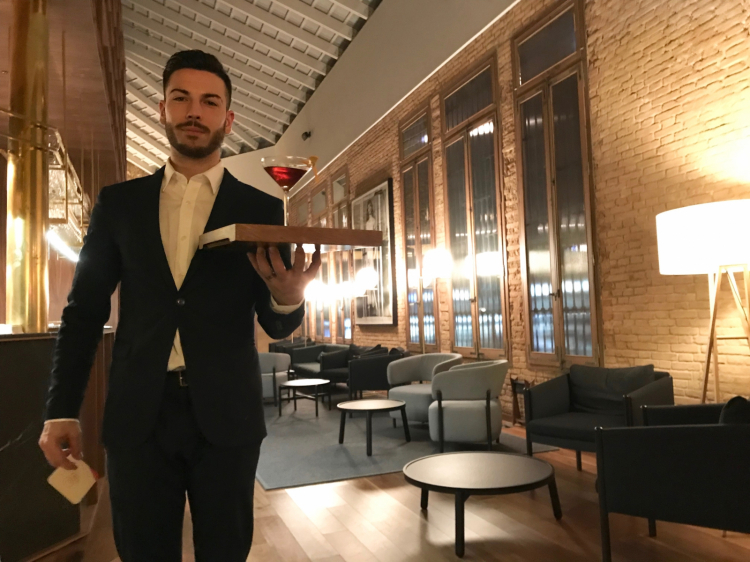
Luca Fabiani serves the welcome cocktail, Bambù Cocktail, with manzanilla sherry, sweet vermouth and dry vermouth. The recipe is from María Dolores Boadas, the "gran dame” of cocktails
They’re the protagonists of an extremely elegant concert, players who know their part inside out, and know they’re part of a potentially perfect mechanism. «Everyone says that
Camarena will get the second star next year», people told us in town, the previous day. Indeed, it looks like it could deserve more. As you can understand from our tastings, which we present now.
Translated into English by Slawka G. Scarso
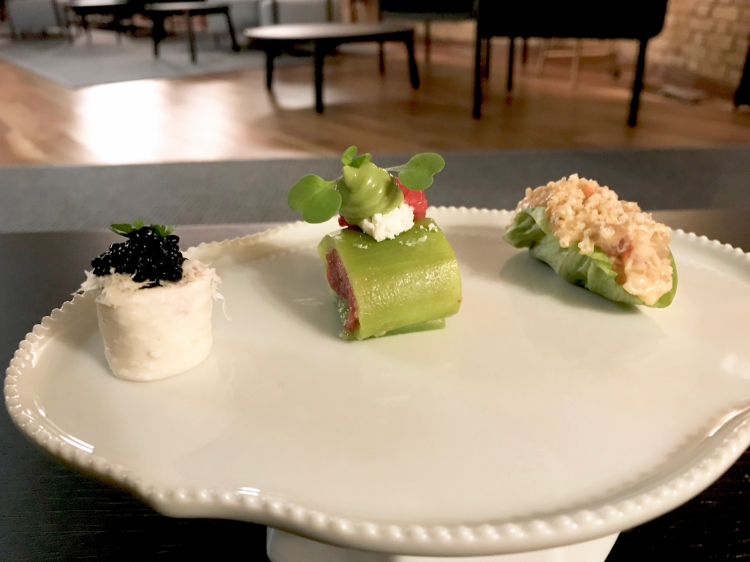
First appetizers, in the dining room, served with the cocktail: Celeriac, horseradish roots and herring roe, good; Courgette, steak tartare, cheese and capers, delicious; Lettuce taco, sea bass Russian salad, very good
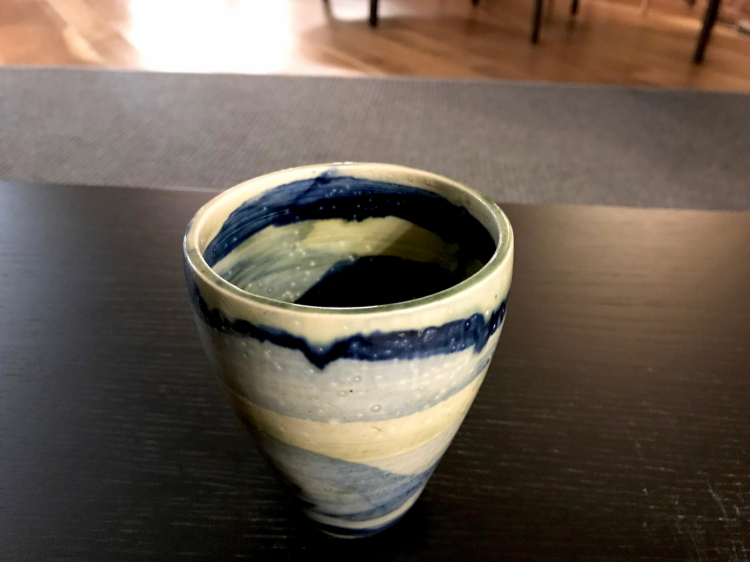
Chicken milk, sherry, lemon leaf, pepper
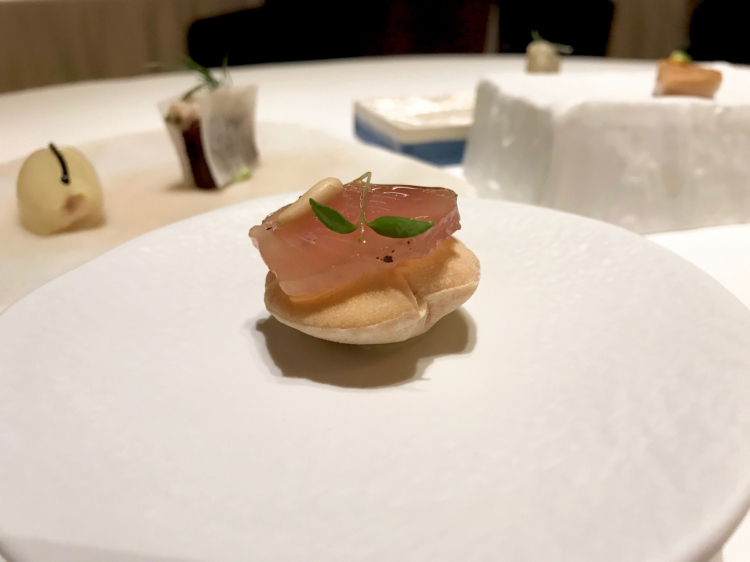
Matured tuna, toasted bread, tuna extract
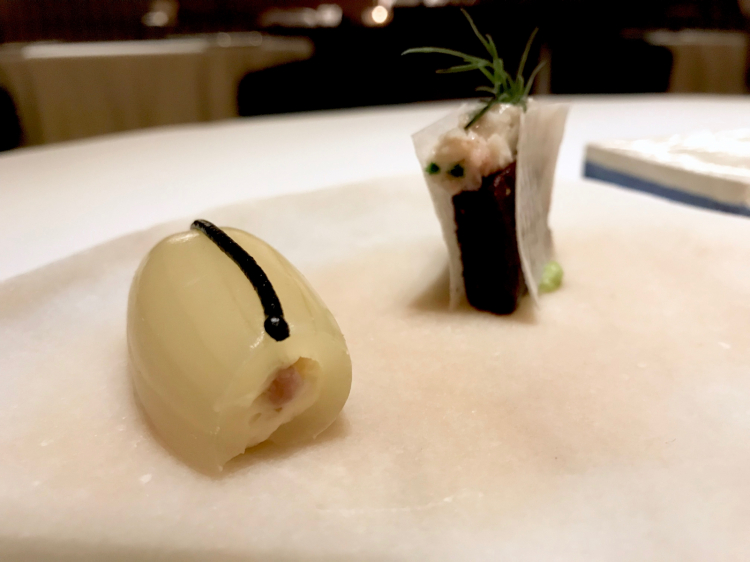
The fabulous Onion, butter with anchovies and black garlic, a sweet-sour, fat-crispy contrast. ThenBeetroot, eel, dill
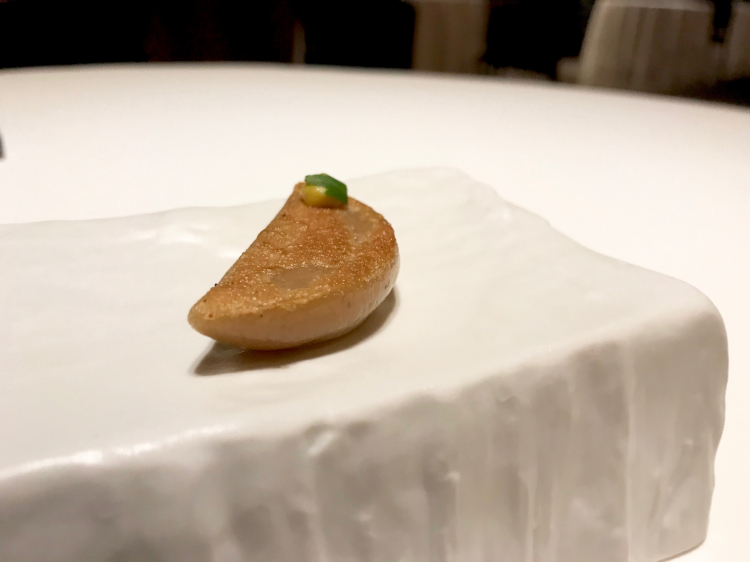
A mini panzerotto: Tomato, mozzarella, anchovy colatura
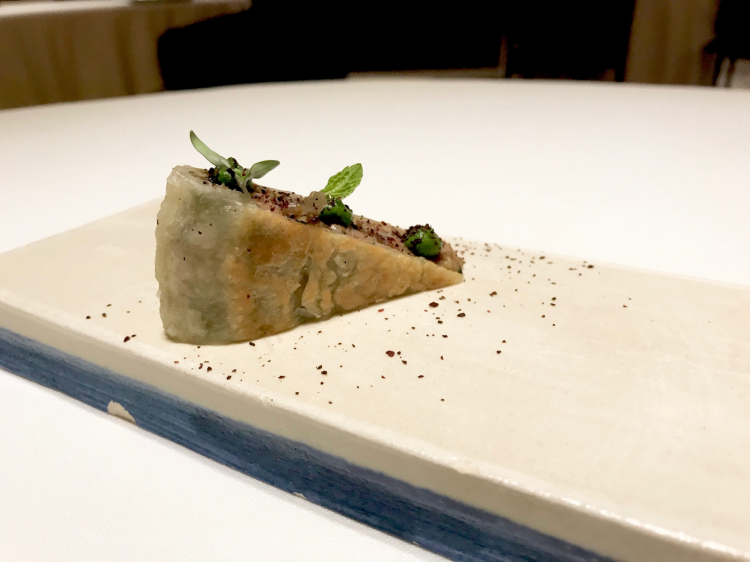
Goat, leek, herbs: delicious
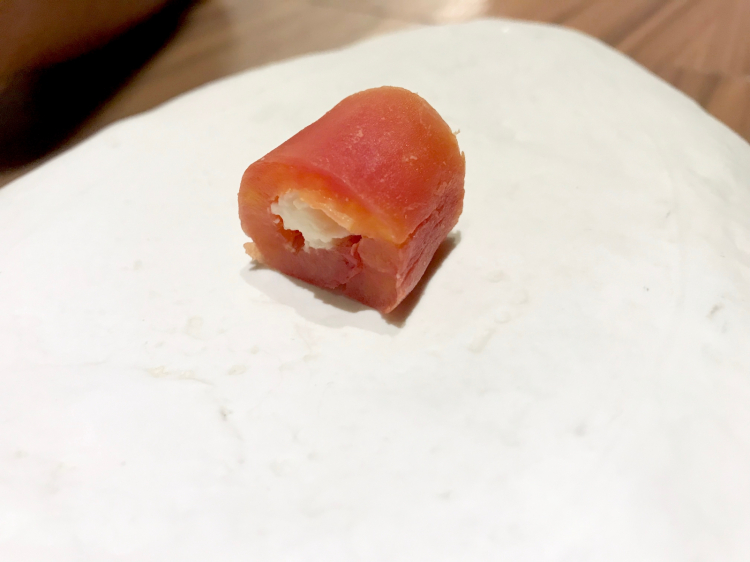
The debut, with tomato, is surprising. Camarena has large vegetable gardens. For two years and a half he tried to grow the perfect tomato «until we found the right formula, enriching the soil with nutrients». Today, he produces tomatoes all year round. Over 5000 kg. What to do with it?
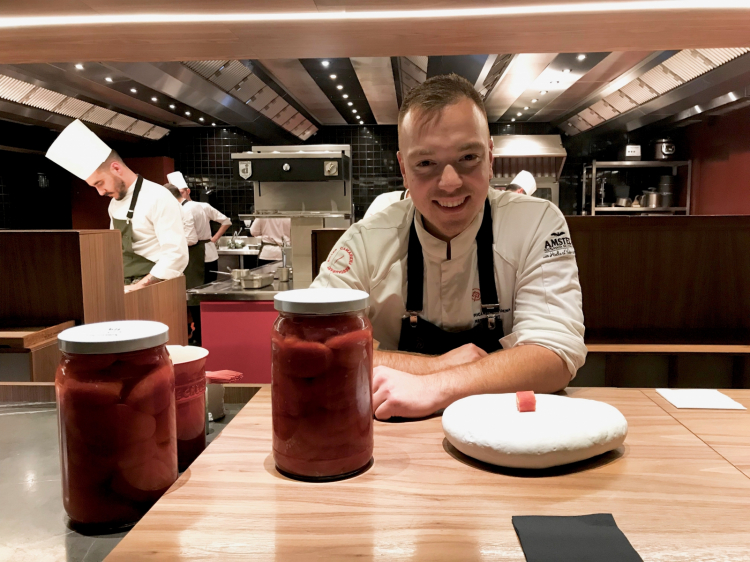
Not preserves, but a semi-preserve: they boil the tomatoes in a vacuum jar for 8 minutes only, then put them into a solution with calcium which preserves texture and aromas. In the picture, some of the jars, with sous chef Jeffrey Van Zijl
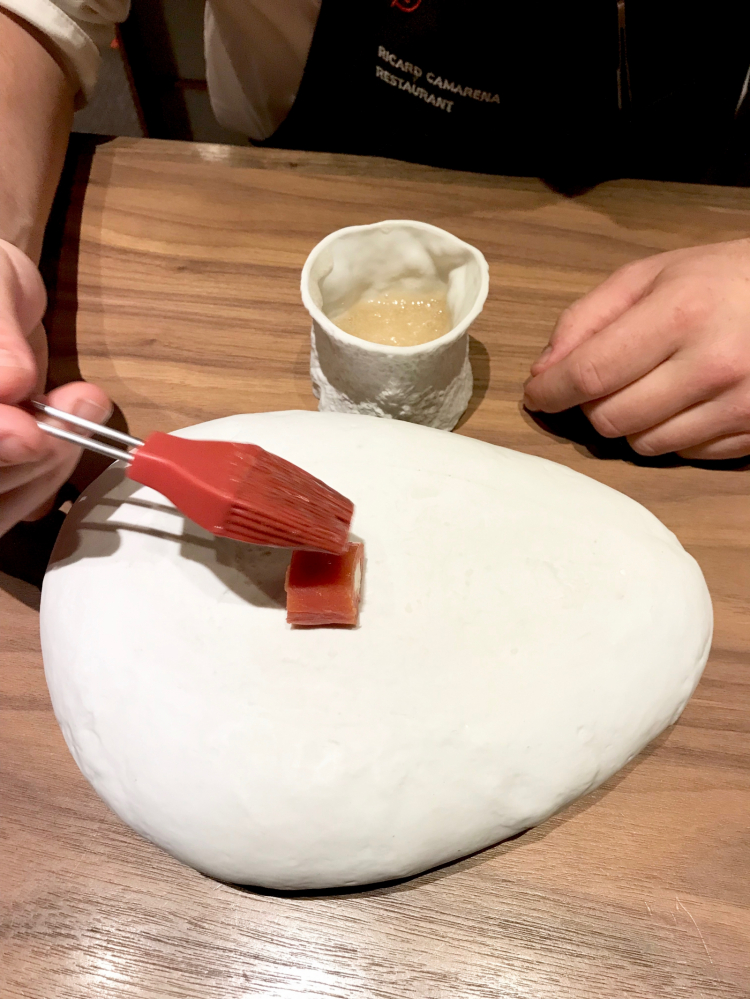
Van Zijl brushes their maison anchovy colatura matured 14 years on the tomato
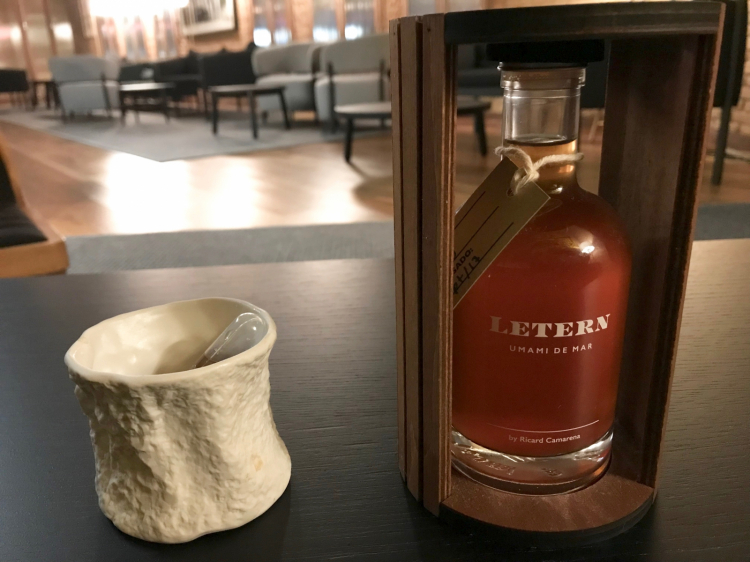
This is Letern, which the chef thus explained: «In 2010, I met an artisan who worked with anchovies here in Valencia. He made a broth of it and I asked him: how do you use it? He said: I keep it for the next year when I fish new anchovies and it becomes like mother yeast. I thought that with that broth I could make something different, something fantastic. We started experimenting and the result is our product, which is made differently from Italian anchovy colatura. We’ve established the type of anchovy, the season, the methodology, if we have to use roe or not, the amount of fat, and so on». It’s more balanced, it has a rounder flavour. Suave they say here: 4 years of fermentation, and then there’s a special version, with 14 years of fermentation: it’s black, spectacular, powerful
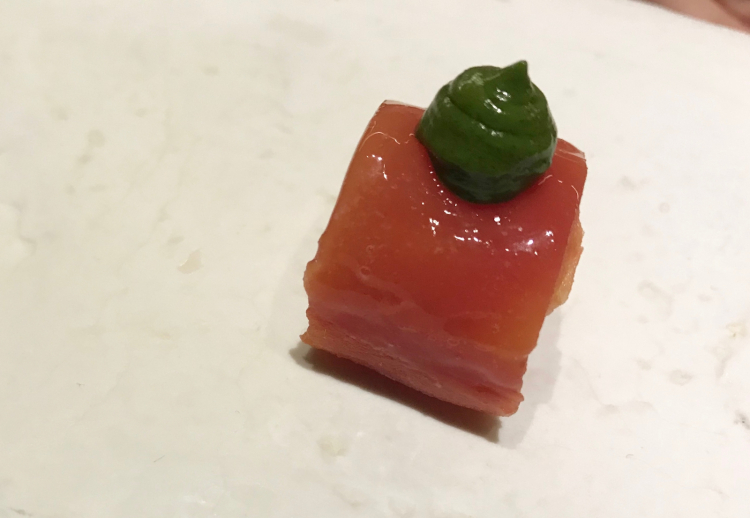
Tomato, mozzarella, basil and colatura, finished
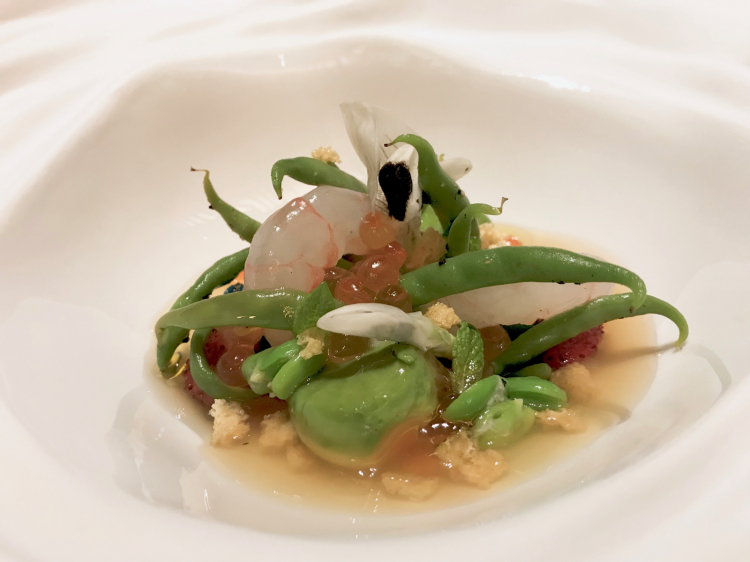
Prawn salad, broad beans, tomato water and wild strawberries
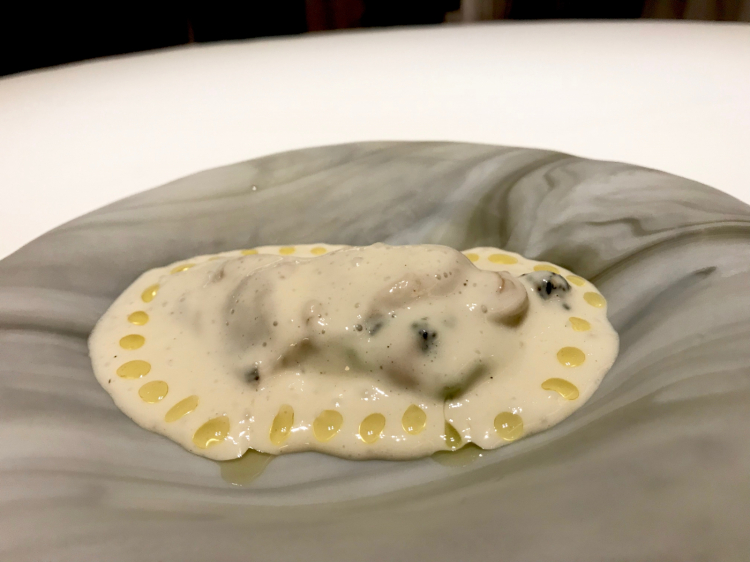
A super classic from the chef, in the menu since 2012: Oyster from Valencia, avocado, sesame and horchata di galanga, then lemon and kimchi to add acidity. Pointless to say it’s a blast of aromas
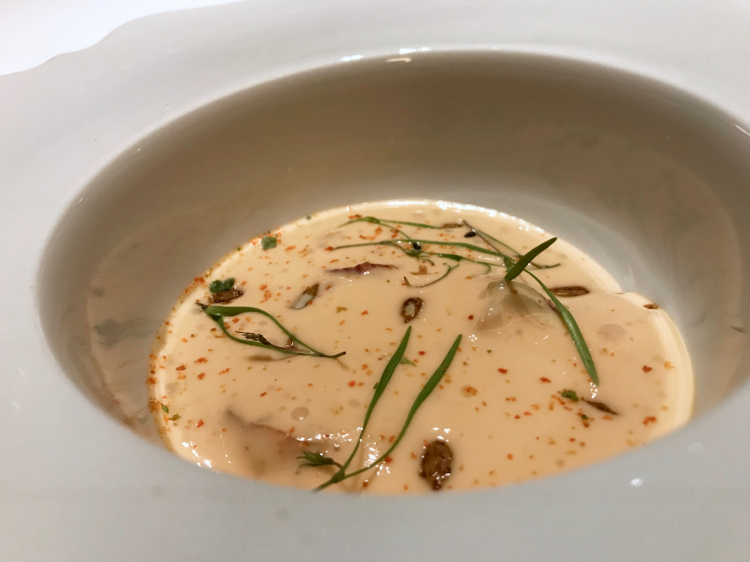
Delicious Blue lobster with its lukewarm meunière, another classic from the chef
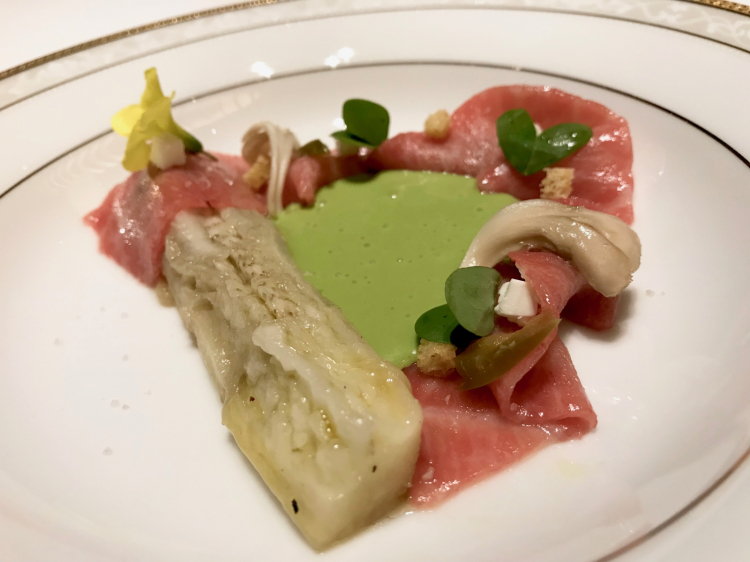
An incredible dish: Roasted aubergine, red tuna and emulsion of oxalis, «it grows below the citrus trees. It’s a sort of natural vinegar». Smoky notes, the tuna adds fat aromas, a perfect contrast with the vegetal-sour notes of the oxalis. It’s a cold dish, but it warms your heart
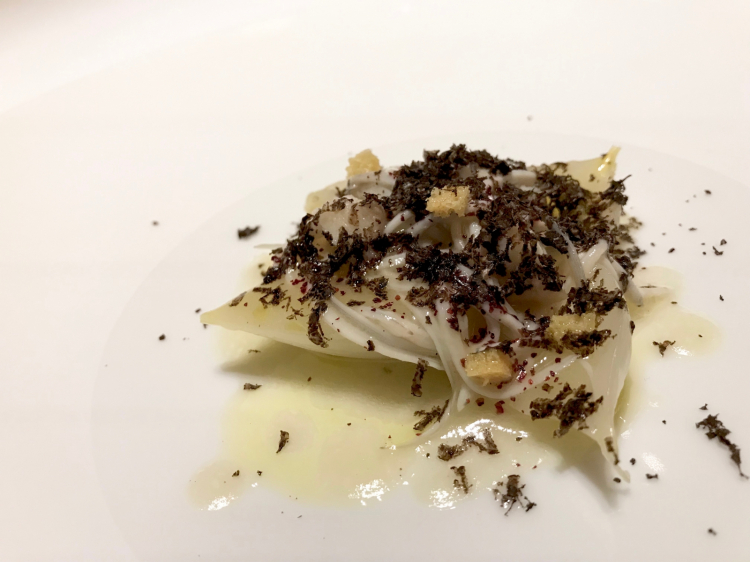
Another masterpiece: Angulas, roasted onions, eel broth and truffle. The angulas are very precious (and expensive) baby eels. The dish recreates the life of an eel, which lives between water and earth, the latter giving it its aroma, from the truffle and the crispy onion. Once again, the perfect acidity
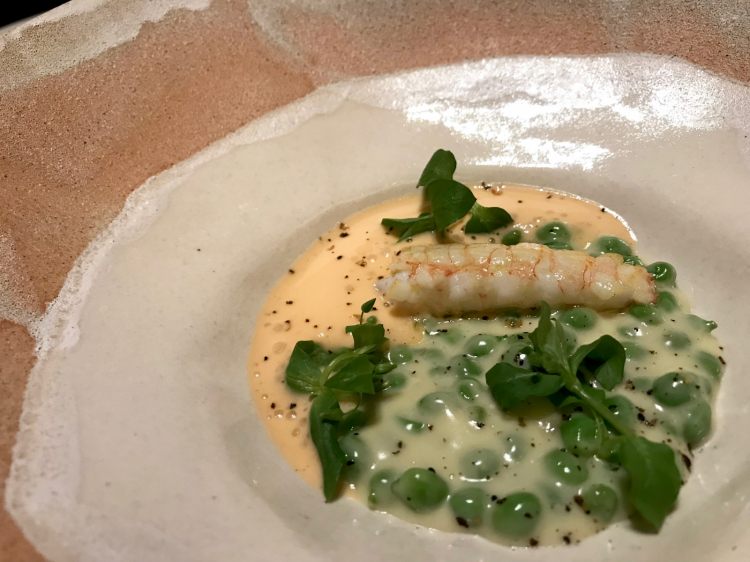
Scampi with peas, the cream of the two ingredients, asparagus and coconut
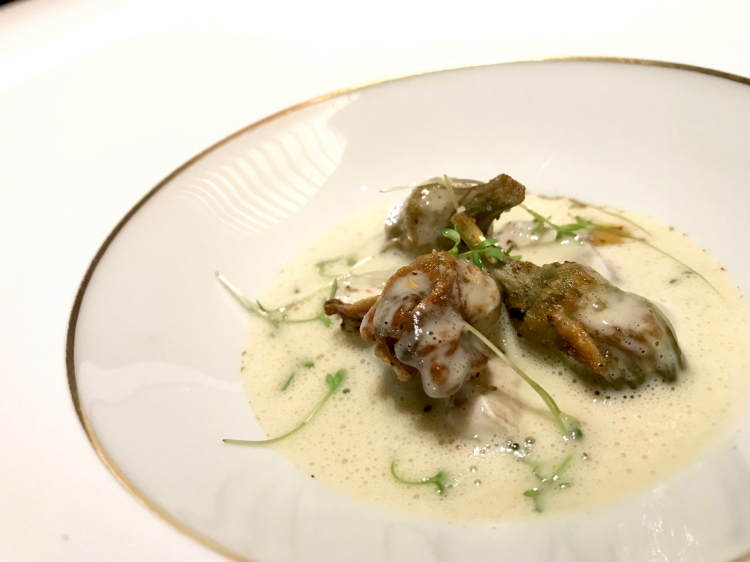
Hake cocochas, fried artichokes, egg yolk and zaatar, a Middle Eastern mix of spices
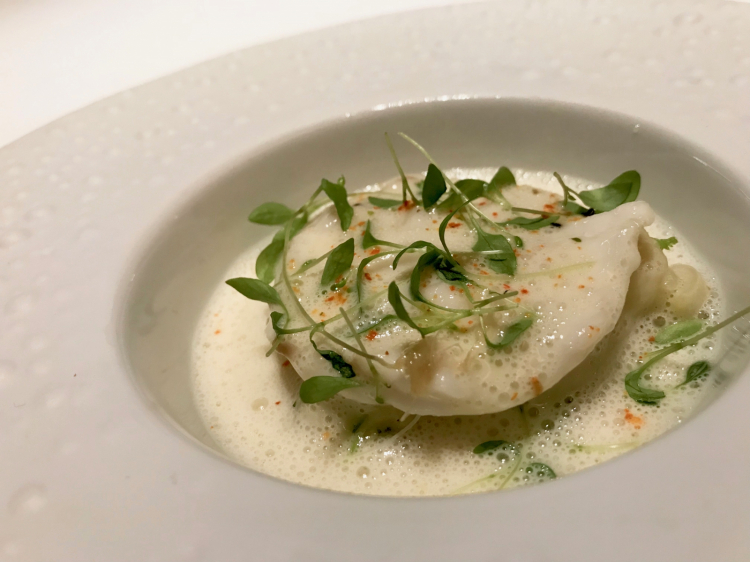
Turbot, potatoes, parsley. Camarena makes a masterful use of acidity: in this case the contrast is between the Hollandaise and meunière sauces and the aroma of combava
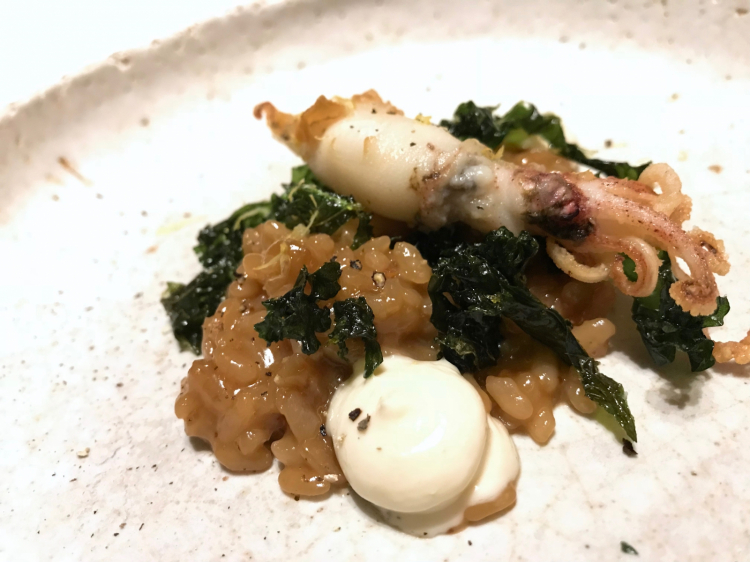
Rice with squid, onions, green cabbage and black pepper. The "rice" is in fact socarrat, a Valencian word that in Castellan means requemadito; it’s basically the rice that’s burnt at the bottom of a pan of paella. In this case it is rehydrated with a mousse of calamari
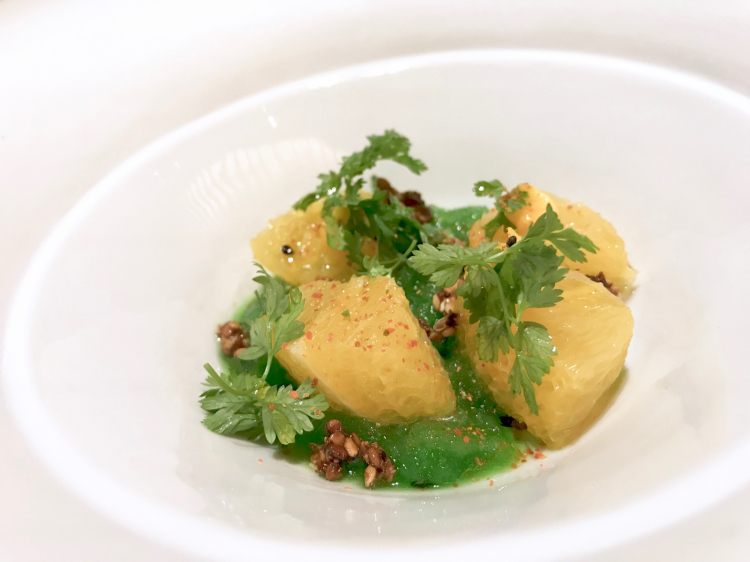
Orange, eucalyptus, chervil. The notes of the eucalyptus are balanced, extraordinary
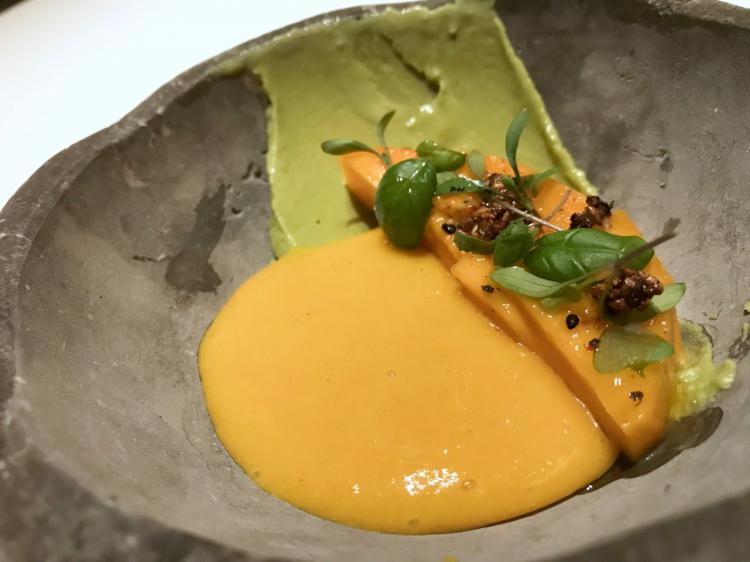
Ripe mango, cold curry, herbs and seeds. Served in a frozen container, so that the creams turn into a sorbet. Delicious
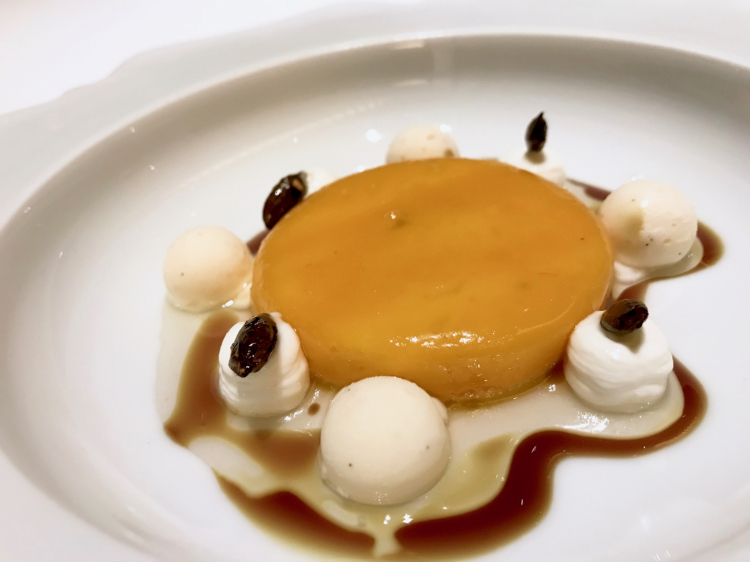
Hot pumpkin cake, yogurt ice cream and ginger. Brilliant until the end. It’s a great dessert, with toasted notes of seeds. The texture of the roasted pumpkin cake (typical of Valencia) is extraordinary: inside, it’s creamy, outside is solid, like mochi